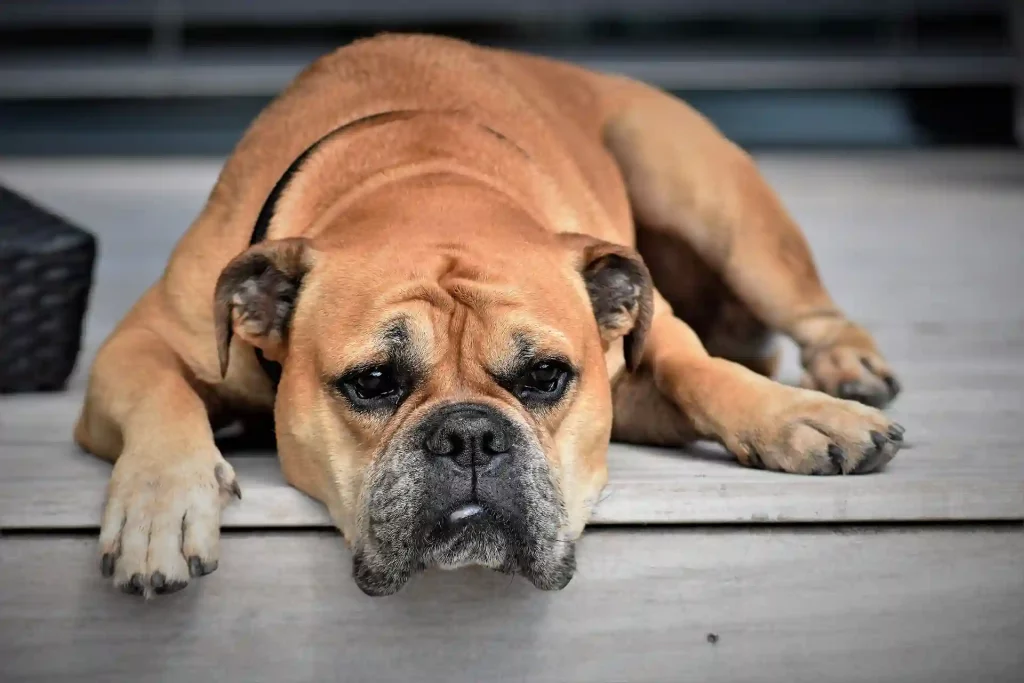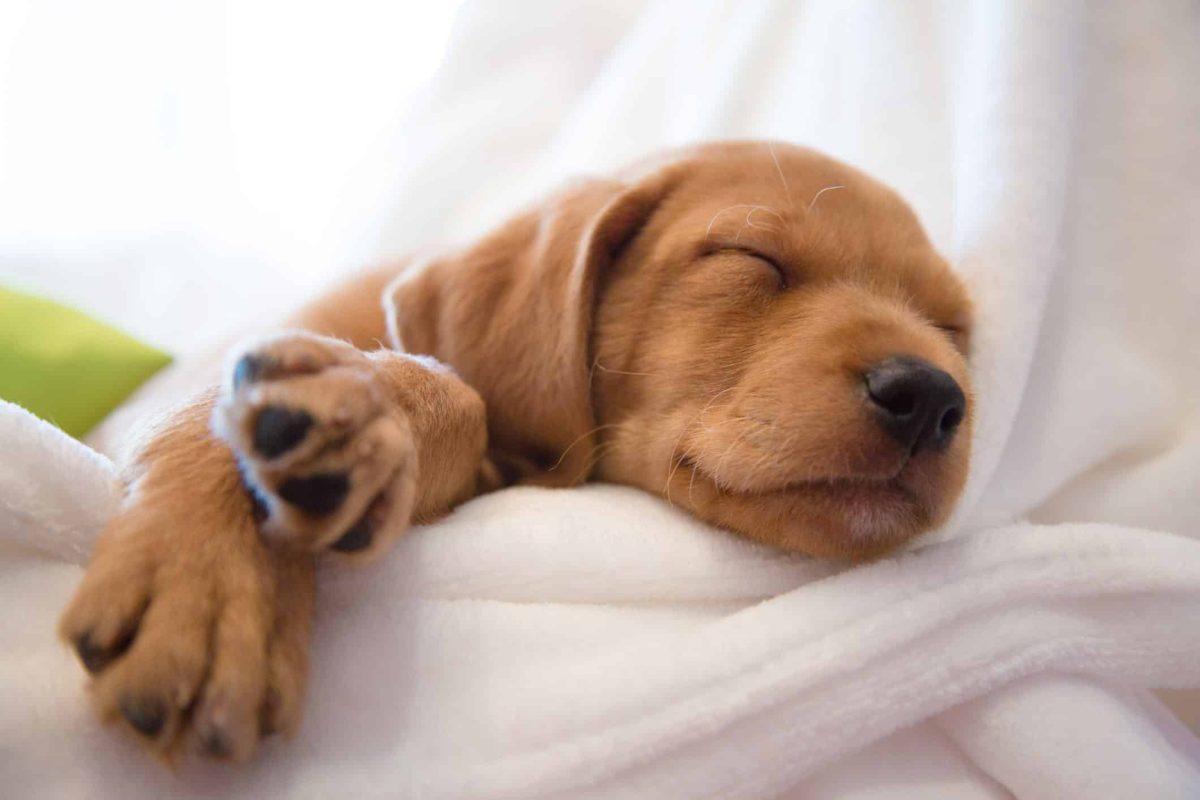Have you ever watched your pup while they sleep and wondered “Do dogs dream”? Like a sleeping beauty, dogs may appear peaceful and still, but just like us, their minds are running wild with dreams.
Unveiling the mystery behind canine sleep patterns can help us better understand our furry little friends.
Key Takeaways
- Dogs sleep longer than humans, averaging 12 to 14 hours a day.
- Dogs experience shorter dream phases, with REM sleep making up approximately 10% of their sleeping cycle time.
- Dogs may twitch or move their legs during dreams, indicating they are actively dreaming.
- Dogs have more extended periods of REM sleep than humans, suggesting that they may have longer and more vivid dreams.
What Do We Know About Dog Dream Patterns & Twitching
We know that dogs typically sleep for much longer than humans, and their sleep patterns can vary greatly. Have you ever noticed how many hours your dog can sleep? It feels like my dog is sleeping on and off for more than 15 hours a day. Dog dream times are usually shorter than us Humans, and the time spent in REM Sleep is approximately 10% of their sleeping cycle time.
Sleeping dog times can range from 12 to 14 hours a day, depending on the age and breed of the dog. Brain activity during this stage of sleep is similar to what humans experience during our own sleep cycles.
Dogs also have nightmares, but they occur less frequently than in humans. Ultimately, it’s still unclear exactly how much time dogs spend dreaming or if they even have dreams at all.
Comparing The Like Humans and Dog Sleep Cycles
You’ll notice that a dog and human have different sleep cycles. Dogs usually sleep for longer periods of time than humans do, but they also experience shorter dream phases. During the dream phase, dogs can twitch or move their legs as if they are running, much like humans do during a nightmare. This doesn’t always mean the dog is having a bad dream, just like with humans it may just be a sign of REM sleep.
Dogs may also have longer dreams than humans do and can even have nightmares like us, although this isn’t common. It’s unknown how similar dog dreams are to human ones; however, both species seem to experience something similar when sleeping.
How Do We Know If Dogs Have Nightmares or Dreams
| To know if a dog is dreaming, you need to pay attention to its movements and behaviors during sleep. | Large Dog | Puppy | Small Dog | Smaller Dog |
|---|---|---|---|---|
| Rapid Eye Movement (REM) Time | 5 Minutes | 10 Minutes | 15 Minutes | 20 Minutes |
| Dogs Do Dream Time | 8 Hours | 12 Hours | 16 Hours | 18 Hours |
| Adult Dogs Wake Your Dog Time | 4 Times/Day | 6 Times/Day | 8 Times/Day | 10 Times/Day |
| Likely Dream More Often Time | 30 Seconds | 45 Seconds | 1 Minute | 2 Minutes |
Evidence suggests that all dogs dream, but the amount of time they spend in REM sleep varies depending on their size. Large dogs tend to have shorter REM times while puppies can spend up to double that. Smaller and smaller dogs have even longer times with adult dogs having the longest. Knowing when your pup is dreaming helps you determine the best time to wake them up without interrupting their restful state.
What Can We Tell About a Dog’s Dreams
By observing your dog’s behaviors and movements during sleep, you can gain insight into what they’re dreaming about. Dogs have longer periods of REM sleep than humans do, and this is generally when they will be having dreams.
If you see your dog twitching their legs or moving around a lot while sleeping, it’s likely that they are dreaming. Dogs may dream about things they’ve experienced recently in their life or things that excite them — like playing fetch or going for a walk.
During REM, the sleeping brain functions much like it does when awake. Dogs and people dream about things that occurred during their waking hours.
We don’t know exactly what dogs dream about, but as a dog owner, you can think about the activities your pup enjoys most and imagine what kind of dreams they might have. Maybe they are dreaming about a nice juicy steak! Ultimately, all we can do is speculate; however, by paying close attention to our canine companions we can get an idea of the kinds of things our dogs may dream about!
Understanding Sleep Disorders in Dogs
Understanding sleep-related disorders in dogs can be a tricky endeavor, as there are a variety of potential causes. Dog twitching is an obvious sign that they may be acting out their dreams, but it’s not the only indication of a possible sleep disorder.
Humans and dogs have similar sleep patterns, with both going through REM (Rapid Eye Movement) and non-REM phases of rest. Dogs also tend to dream more often than humans do – larger dogs have longer dreams than smaller breeds – and middle-aged dogs experience the most frequent dreaming episodes.
A good night’s sleep for your pup should also include plenty of time spent in deep REM sleep, as this is when the body repairs itself and refreshes energy levels. If you suspect your pooch has a sleeping disorder, speaking to your veterinarian about possible solutions is a good next step.

Waking a Dog During a Dream or Nightmare
Interrupting a dog’s dream can be disruptive to their sleep, so it is best to let them finish the cycle naturally. During REM sleep, you may see your dog twitching or acting out their dreams. It is difficult to tell when your dog is dreaming, but humans and dogs experience similar REM sleep phases, suggesting that dogs likely dream too.
Older dogs may have more frequent dreams than younger ones. Regardless of age, waking a dog during a dream can cause sleep disorders or make them irritable. To ensure your pup gets the rest they need, it’s best to not wake them up unless absolutely necessary.
- Dogs likely dream
- Acting out their dreams
- Tell when your dog is dreaming
- Wake a dog only if necessary
Differences in Dog Breeds and Dreaming
Now that we know waking a dog during a dream can be risky, let’s explore the differences between dog breeds and dreaming.
It’s likely that all dogs experience dreams while they sleep, but some may act out their dreams more than others. Smaller breeds are known to twitch or move their legs while sleeping as if they are running – just like humans do when dreaming.
Larger breeds tend to stay still while asleep, though they may grumble or vocalize from time to time which could indicate that they too are having a dream. It can be difficult to tell when your dog is having a dream since some dogs also have sleep disorders; however, if you pay close attention you might notice them twitching or moving around during the REM sleep phase.
Studies show that both humans and dogs seem to experience dreams in similar ways – making it even more intriguing why dogs sometimes act out their dreams!
Frequently Asked Questions
Does the Type of Diet a Dog Eats Affect Its Sleep Patterns?
Yes, diet does affect a dog’s sleep patterns. Feeding them the right nutrition helps balance their energy levels and encourages restful sleep.
Do Dogs Need a Certain Amount of Sleep Each Day?
Yes, dogs need a certain amount of sleep each day. Just like people, they can suffer if they don’t get enough rest. Alluding to the saying “let sleeping dogs lie,” make sure your pup gets plenty of zzz’s!
Are There Any Long-Term Health Risks Associated With Lack of Sleep in Dogs?
Yes, lack of sleep in dogs can cause long-term health risks. Your pup may suffer from anxiety, stress, and depression if they don’t get enough rest each day.
How Do Changes in Environmental Factors, Such as Temperature and Noise, Affect a Dog’s Sleep Patterns?
Changes in environmental factors, like temperature and noise, can disrupt a dog’s sleep patterns. They can cause your pup to wake up more often or even prevent them from sleeping at all.
Is There a Way to Tell if a Dog Is Having a Nightmare?
You may be able to tell if your dog is having a nightmare based on physical cues such as increased heart rate, panting, or yelping. If you notice these signs, gently wake your pup up and provide comfort.
Conclusion
We may never fully understand what our furry friends dream about, but we can be sure that they experience something similar to us. The twitching of their legs and the occasional bark are evidence that they’re dreaming just like us.
Imagining them running wild in their own little world brings warmth to our hearts and reminds us of why we love them so much. We can only hope that their dreams are filled with adventure and joy, just as ours are.
